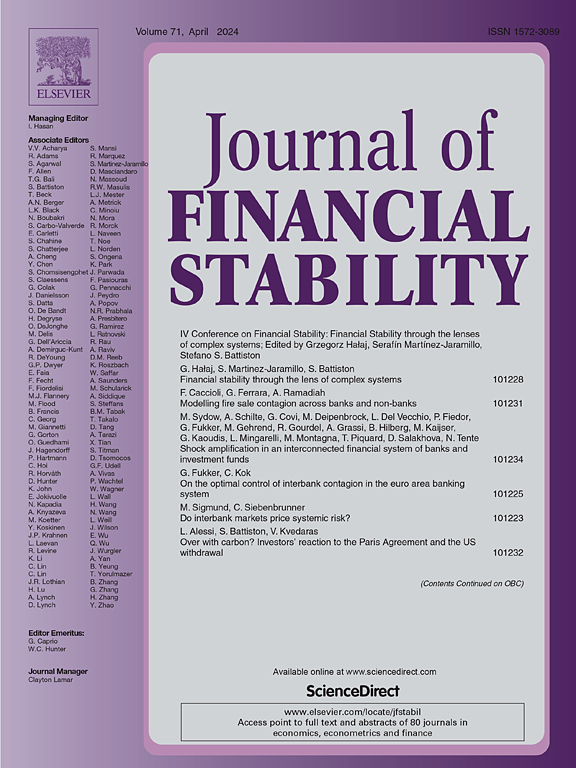稳健而不脆弱:在基于主体的宏观模型中应对系统性风险和金融传染
IF 4.2
2区 经济学
Q1 BUSINESS, FINANCE
引用次数: 0
摘要
我们通过引入货币市场中不断发展的银行间网络,扩展了熊彼特与凯恩斯(K+S)基于代理人的模型。银行面临交易对手风险,并使用网络估值(NEVA)清算机制评估银行间头寸,该机制确保系统风险最小化,对银行行为的假设最小。该模型可以复制关于银行间网络拓扑结构和银行资产负债表动态的几个程式化事实。该模型包含了金融传染和系统性风险,使我们能够研究微观和宏观审慎政策之间的相互作用。我们的研究结果表明,引入考虑网络结构的微观审慎监管可以降低系统性风险事件的发生率。我们还发现,在基于《巴塞尔协议III》宏观审慎监管和基于新能源法的微观审慎监管的双支柱监管框架的存在下,金融稳定与宏观经济表现之间不存在权衡。这表明,有可能设计出一种监管框架,既能实现金融稳定,又不需要过于严格的资本金要求。本文章由计算机程序翻译,如有差异,请以英文原文为准。
Robust-less-fragile: Tackling systemic risk and financial contagion in a macro agent-based model
We extend the Schumpeter meeting Keynes (K+S) agent-based model by introducing an evolving interbank network in the money market. Banks are exposed to counterparty risk and evaluate interbank positions using a network valuation (NEVA) clearing mechanism, which ensures systemic risk minimization with minimal assumptions on banks’ behavior. The model can replicate several stylized facts about the topology of the interbank network and the dynamics of banks’ balance sheets. The model encompasses financial contagion and systemic risk, allowing us to study the interactions between micro- and macro-prudential policies. Our results suggest that the introduction of a micro-prudential regulation also accounting for the network structure can reduce the incidence of systemic risk events. We also find that, in presence of a two-pillar regulatory framework – grounded on a Basel III macro-prudential regulation and a NEVA-based micro-prudential one –, there is no trade-off between financial stability and macroeconomic performance. This points towards the possibility of designing a regulatory framework able to achieve financial stability without overly stringent capital requirements.
求助全文
通过发布文献求助,成功后即可免费获取论文全文。
去求助
来源期刊

Journal of Financial Stability
Multiple-
CiteScore
7.70
自引率
9.30%
发文量
78
审稿时长
34 days
期刊介绍:
The Journal of Financial Stability provides an international forum for rigorous theoretical and empirical macro and micro economic and financial analysis of the causes, management, resolution and preventions of financial crises, including banking, securities market, payments and currency crises. The primary focus is on applied research that would be useful in affecting public policy with respect to financial stability. Thus, the Journal seeks to promote interaction among researchers, policy-makers and practitioners to identify potential risks to financial stability and develop means for preventing, mitigating or managing these risks both within and across countries.
 求助内容:
求助内容: 应助结果提醒方式:
应助结果提醒方式:


